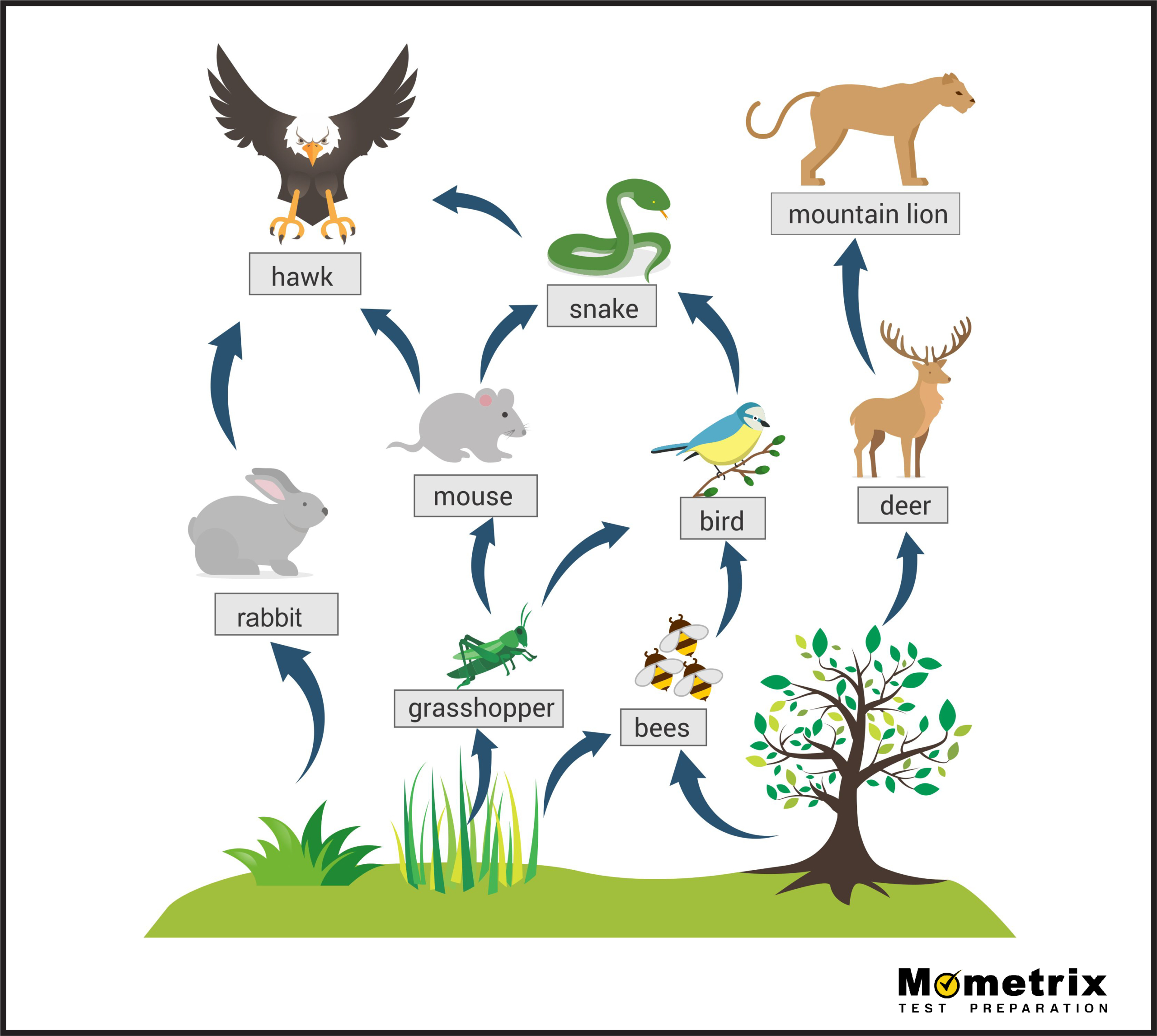What are the three states of matter?
Solid, liquid, and gas
What causes the seasons?
The tilt of the Earth's axis as it orbits the sun
 Name an energy transfer between two creatures in this food web.
Name an energy transfer between two creatures in this food web.
Answers may vary.
In this food web, one example of an energy transfer is from the grass to the rabbit.
The rabbit eats the grass to get energy, which means the energy from the grass is transferred to the rabbit.
Will water evaporate faster in the sun or in the shade?
In the sun
What is kinetic energy?
The energy of motion
What is the conservation of matter?
Matter is never created or destroyed, it just changes form.
What causes day and night?
The rotation of earth on its axis
What is a fossil?
A fossil is the preserved remains or traces of a plant or animal that lived long ago.
Where are earthquakes most likely to occur?
Earthquakes are most likely to occur along tectonic plate boundaries—these are places where Earth's giant plates meet and move.
What is the difference between a balanced and unbalanced force?
Balanced forces are equal and opposite, so they cancel each other out. This means the object stays still or keeps moving at the same speed and direction.
Unbalanced forces are not equal, so they change the motion of an object. The object might start moving, speed up, slow down, or change direction.
A thermal conductor is a material that lets heat move through it easily.
Example: Metal (like a spoon in hot soup—it gets hot fast).
An insulator is a material that does NOT let heat move through it easily.
Example: Wood, plastic, or a potholder (they keep your hands from getting burned).
Will we see the same constellation in the Northern Hemisphere in the summer and in the winter? Why or why not?
No. As the Earth orbits around the Sun during the year, we are facing different parts of space at night.
That means in summer, we look out into one part of the sky and see certain constellations (like Scorpius), and in winter, we look in the opposite direction and see different ones (like Orion).
Could we find the fossil of the whale in a desert ecosystem? Why or Why not?
Yes - ecosystems could change over time.
What are some safety measures people should take when a hurricane is approaching?
Listen to weather alerts and follow instructions from local officials.
Evacuate if told to—leave early and know your evacuation route.
Board up windows or use storm shutters to protect your home.
Bring in outdoor items like furniture or toys so they don’t blow away.
Have an emergency kit with water, food, flashlight, batteries, medicine, and important papers.
Charge phones and backup batteries in case the power goes out.
Stay indoors and away from windows during the storm.
What is an electromagnet?
An electromagnet is a magnet that is made using electricity!
It works by wrapping wire around a piece of metal (like iron) and then sending electricity through the wire. This creates a magnetic field, turning the metal into a magnet. When the electricity is turned off, the magnetism goes away.
What is an example that a new substance has been formed?
Color Change, Weight Change, Gas forms, Change in temperature
What causes the different phases of the moon?
The Moon doesn’t make its own light—it reflects light from the Sun.
As the Moon orbits the Earth, we see different parts of the lit side.
That’s what causes the phases—like new moon, crescent, half moon, full moon, and so on.
What is an external feature of a duck and how does that feature help it in its environment?
Answers may vary.
An external feature of a duck is its webbed feet.
Webbed feet help ducks swim efficiently in water. The webbing acts like a paddle, allowing ducks to push against the water and move quickly and smoothly. This helps them find food, escape predators, and travel through lakes, ponds, and rivers.
What is a landform that might be found near a tectonic plate boundary?
Mountain chains, volcanoes, ocean trenches
How does speed affect motion energy?
Faster objects have more motion energy.
Draw a model of matter particles when they are in the solid, liquid, and gas states.

Is the Sun the brightest star in our Solar System? Why or why not?
The Sun is a star that appears larger and brighter than other stars. The other stars are actually much brighter, but the Sun appears brighter in the sky than these stars because the Sun is the closest star to Earth and these stars are much further away.
What is photosynthesis?
Photosynthesis is the process that plants use to make their own food.
What happens to water in the water cycle?
Evaporation: The sun heats up water in rivers, lakes, and oceans, turning it into water vapor (a gas) that rises into the air.
Condensation: The water vapor cools down and changes back into tiny droplets, forming clouds.
Precipitation: When the droplets get heavy, they fall to the ground as rain, snow, sleet, or hail.
Collection: The water collects in oceans, rivers, lakes, or soaks into the ground. Then the cycle starts all over again!
What is static electricity?
Static electricity is a type of electricity that happens when electric charges build up on the surface of an object.
It usually happens when two things rub together, like a balloon on your hair.